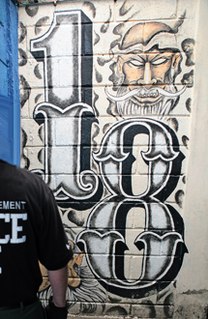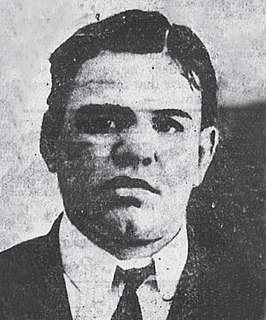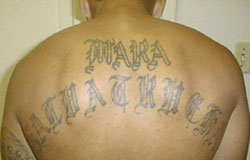
18th Street, also known as Calle 18, Barrio 18, Mara 18, or simply La 18 in Central America, is a multi-ethnic transnational criminal organization that started as a street gang in Los Angeles. It is one of the largest transnational criminal gangs in Los Angeles, with 65,000 members between the United States, Mexico, and Central America and is also allied with the Mexican Mafia, another US-based crime organization. A United States Department of Justice report featured the following statement regarding 18th Street and rival gang MS-13, "These two gangs have turned the Central American northern triangle into the area with the highest homicide rate in the world."

The Chichesters also known as the Chichester Gang, along with the Forty Thieves, Shirt Tails, and Kerryonians, were one of the oldest early 19th century Irish Five Points street gangs during the mid 19th century in New York City. The Chichester Gang was organized by its founder John Chichester. The gang got their start by stealing from stores and warehouses and selling the stolen goods to local fences in the 1820s and later became involved in illegal gambling and robbery. An ally of the Dead Rabbits against the Bowery Boys, the Chichesters maintained between 50-100 members lasting for more than 50 years before being absorbed by the Whyos, much like many of the early gangs, following the American Civil War in 1865.
The Honeymoon Gang was a New York street gang of the mid 19th century. The gang was said to be so violent that they were denied protection often received by other street gangs from Tammany Hall politicians.
The Slaughter House Gang, known as the Slaughter Housers, were a prominent street gang in New York's Fourth Ward during the late 1840s to the mid-1860s.

Hugh Leonard Thompson Murphy was a Northern Irish loyalist and UVF officer. As leader of the Shankill Butchers gang, Murphy was responsible for many murders, mainly of Catholic civilians, often first kidnapping and torturing his victims. Due to a lack of evidence, Murphy was never brought to trial for these killings, for which some of his followers had already received long sentences in 1979. In the summer of 1982, Murphy was released just over half-way through a 12-year sentence for other offences. He returned to the Shankill Road, where he embarked on a murder spree. Details of his movements were apparently passed by rival loyalist paramilitaries to the Provisional IRA, who shot Murphy dead that autumn.
James Michael Coonan, nicknamed "Jimmy C", is an Irish-American mobster and racketeer from Manhattan, New York who, from approximately 1977 to 1988, served as the boss of the Westies gang, an Irish mob group based in Hell's Kitchen. Coonan was incarcerated and began serving a 75-year prison term in 1988.

The Charlton Street Gang was a New York City street gang and river pirates during the mid-nineteenth century.
The Cherry Hill Gang was a New York street gang during the late nineteenth century.
The Dutch Mob was a New York pickpocket gang during the late nineteenth century.

The Morello crime family was one of the earliest crime families to be established in the United States and New York City. The Morellos were based in Manhattan's Italian Harlem and eventually gained dominance in the Italian underworld by defeating the rival Neapolitan Camorra of Brooklyn. They were the predecessors of what eventually became known as the Genovese crime family.
Wah Ching, meaning Chinese Youth, is a Chinese American criminal organization and street gang that was founded in San Francisco, California in 1964. The Wah Ching has been involved in crimes including narcotic sales, racketeering and gambling.
Gang-related organised crime in the United Kingdom is concentrated around the cities of London, Manchester and Liverpool and regionally across the West Midlands region, south coast and northern England, according to the Serious Organised Crime Agency. With regard to street gangs the cities identified as having the most serious gang problems, which also accounted for 65% of firearm homicides in England and Wales, were London, Birmingham, Manchester and Liverpool. Glasgow in Scotland also has a historical gang culture with the city having as many teenage gangs as London, which had six times the population, in 2008.

The Eastman Gang was the last of New York's street gangs which dominated the city's underworld during the late 1890s until the early 1910s. Along with the Five Points Gang under Italian-American Paolo Antonio Vaccarelli, best known as Paul Kelly, the Eastman gang succeeded the long dominant Whyos as the first non-Irish street gang to gain prominence in the underworld during the 1890s. Its rise marked the beginning of a forty to fifty-year period of strong Jewish-American influence within organized crime in New York City.
The Forty-Two Gang is a teenage street gang in Chicago that started during Prohibition. Like Brooklyn's Italian and Jewish street gangs of Brownsville and Ocean Hill, the Forty-Two Gang serves as a "farm team" for future members of the Chicago Outfit. Forty-Two Gang members include future syndicate members Sam Giancana, Sam "Teets" Battaglia, Luigi "Cockeyed Louie" Fratto, Felix "Milwaukee Phil" Alderisio, "Mad Sam" DeStefano, Charles "Chuckie" Nicoletti, Fiore "Fifi" Buccieri, William "Smokes" Aloisio, Frank "Skids" Caruso, William "Willie Potatoes" Daddano, Joseph DiVarco, Marcello Caifano, Mario DeStefano, Bruno Tassione, and Joey "Cowboy" Miletta.

Gangs in the United States include several types of groups, including national street gangs, local street gangs, prison gangs, motorcycle clubs, and ethnic and organized crime gangs. Approximately 1.4 million people were part of gangs as of 2011, and more than 33,000 gangs were active in the United States.
South Brooklyn Boys is a famous New York City street gang. In the 1950s, various Italian-American gangs were formed in South Brooklyn, New York City, and came together under the moniker of "South Brooklyn Boys" sometime around the 1950s. The gang has a mostly Italian American membership.

Mara Salvatrucha, commonly known as MS-13, is an international criminal gang that originated in Los Angeles, California, in the 1970s and 1980s. Originally, the gang was set up to protect Salvadoran immigrants from other gangs in the Los Angeles area. Over time, the gang grew into a more traditional criminal organization. MS-13 is defined by its cruelty, and its rivalry with the 18th Street gang. They are considered to be the most dangerous and ruthless gang in the world.

The Peaky Blinders were a street gang based in Birmingham, England, which operated from the 1880s until the 1910s. The group, which grew out of the harsh economic deprivations of working-class Britain, consisted largely of young criminals from lower- to middle-class backgrounds. They engaged in robbery, violence, racketeering, illegal bookmaking, and control of gambling. Members wore signature outfits that typically included tailored jackets, lapelled overcoats, buttoned waistcoats, silk scarves, bell-bottom trousers, leather boots, and peaked flat caps.

David Thai,, is a Vietnamese-born American gangster who was the founder and leader of the notorious Born to Kill gang during the late 1980s and early 1990s. He was also responsible for running a massive illegal counterfeit watch operation and at his peak controlled the market and distribution of counterfeit watches in New York by means of blackmail and extortion. He was the official leader of Born to Kill from 1988 until his arrest in 1991, which was the combination of months of investigation by the United States Bureau of Alcohol, Tobacco, Firearms and Explosives (ATF) in conjunction with the aid of a former gang member who defected from the gang and became an undercover informant, helping secure the convictions of David Thai and several of his high-ranking officers.

South Kilburn is a large housing estate in Kilburn, in the London Borough of Brent. Typical of brutalist 60's designs of public housing in the United Kingdom it is characterised by high-density housing in low-rise flats and 11 concrete tower blocks. It was approved in 1959 and extended in 1963. This scheme was further developed in the late 1960s and early 1970s; redevelopment occurred during the 2010s. The population is predominantly Afro-Caribbean.